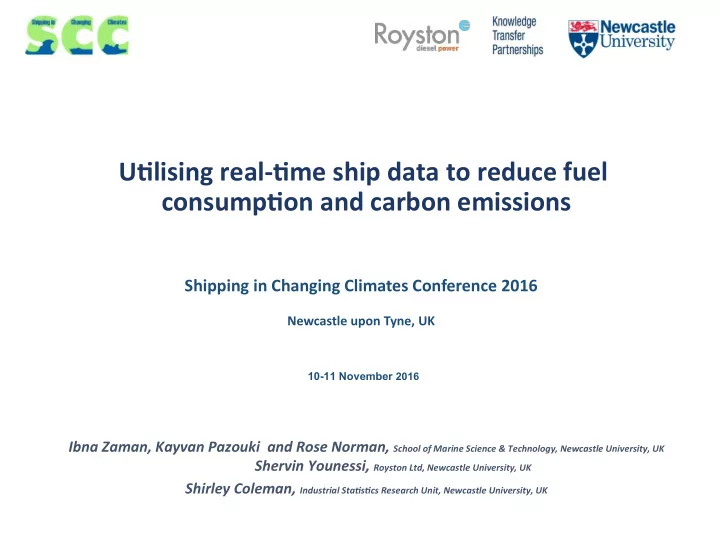

U?lising real-?me ship data to reduce fuel consump?on and carbon emissions Shipping in Changing Climates Conference 2016 Newcastle upon Tyne, UK 10-11 November 2016 Ibna Zaman, Kayvan Pazouki and Rose Norman, School of Marine Science & Technology, Newcastle University, UK Shervin Younessi, Royston Ltd, Newcastle University, UK Shirley Coleman, Industrial StaGsGcs Research Unit, Newcastle University, UK
Shipping Industry Overview � Shipping is the life blood of the global economy and responsible for the carriage of around 90% of trade. � The world’s commercial fleet consists of around 90,000 vessels. � In 2014, total global cargo carried 9.84 billion ton, an increase of 3.4% from 2013. Fuel Sale (2004-2012) 350 The fuel demand estimated to 300 Fuel Sale (million tonnes) 250 double by 2030 due to the 200 150 increase in transport demand. 100 50 0 2004 2005 2006 2007 2008 2009 2010 2011 2012 2 Year Source: Third IMO GHG Study 2014 and Global Marine Fuel Trend 2030
Ship Emissions � Average annual totals of 20.9 million and 11.3 million tonnes for NOx (as NO 2 ) and SOx (as SO 2 ) from all shipping. (2007-2011) � NOx and SOx emissions from all shipping represent about 15% and 13% of global totals. � Responsible for 3% of global CO 2 emissions Increase co 2 emissions 50%- 250% by 2050, depending on economic growth and global energy demand � Combustion emissions of SOx, NOx, PM, CO and NMVOCs are correlated with fuel consumption patterns, with some variability according to properties of combustion across engine types, fuel properties, etc. 3 Source: Third IMO GHG Study 2014
Fuel consump?on reduc?on methods Operational Auxiliary power Aerodynamics Weather routing 1-4% Efficient pumps, fans 0-1% Air lubrication 5-15% Autopilot upgrade 1-3% High efficiency lighting 0-1% Wind engine 3-12% Speed reduction 10-30% Solar Panel 0-3% Thrust efficiency Engine efficiency Hydrodynamics Propeller polishing 3-8% Waste heat recovery 6-8% Hull cleaning 1-10% Propeller upgrade 1-3% Engine control 0-1% Hull coating 1-3% Prop/rudder retrofit 2-6% Engine common rail 0-1% Water flow optimisation 1-4% Engine speed de-rating 10-30% 4 Source: International Council on Clean Transportation (ICCT, July 2013)
ECO Speed Project The main aim is to iden?fy the economical ship speed for the vessel by analysing the ship real-?me data. The OSV Specifications Main Engines 2 x MAK 8M25C 2500kW Shaft Generator 2 x 1440 kW Auxiliary Engines 3 x 585 kW Emergency Generator 1 x 200 kW Bow Thruster 2 x Berg 800 kW Stern Thruster 2 x Berg 800 kW Propeller 2 x CPP 5
ECO Speed Development Process 6 Figure: ECO Speed development process
Data Analy?c Model Pitch Sea state Wind speed Current No Calm Create Weather factor Weather Speed over Fuel Yes ground Consumption Data Collec?on Sta?s?cal Model Collect different • Regression Analysis data set • Basic sta9s9cs Not in accepted range Check R-Sq value Accepted Range Regression model equa?on Generate specific speed 7 curve for a distance
The OSV sea-trial Pitch (%) Avg. SOG (kn) FC (kg/min) 95 12.13 13.75 85 11.24 11.23 75 10.57 8.92 60 9.02 6.41 57 8.5 5.99 50 7.78 5.43 35 5.99 4.55 25 4.52 4.10 10 2.23 4.20 8 Table: The OSV Sea-Trial (Full Engine Speed)
Regression Analysis 9 Figure : Regression model
Fuel Con. vs Speed 10 Figure: The esGmated fuel consumpGon for different speed using regression equaGon
Engine Profile Based Solu?on Addi?onal Fuel Consumed from ref. op?mum speed, Speed Over Es?mated Fuel Con/ Distance of 20 NM Ground (kn) min taken, Time (Hr) Fuel Con-Diff Fuel Con-kg Time Diff (min) Fuel Con- Diff % 3.5 4.21 5.71 1443.85 632.09 182.86 77.87 4 4.25 5.00 1275.38 463.62 140.00 57.11 4.5 4.28 4.44 1141.95 330.19 106.67 40.68 5 4.32 4.00 1036.44 224.68 80.00 27.68 5.5 4.37 3.64 954.34 142.58 58.18 17.56 6 4.46 3.33 892.62 80.86 40.00 9.96 6.5 4.60 3.08 849.22 37.46 24.62 4.61 7 4.80 2.86 822.63 10.87 11.43 1.34 Economical Speed 7.5 5.07 2.67 811.76 0.00 0.00 0.00 (Datum) 8 5.44 2.50 815.80 4.04 -10.00 0.50 Crew Speed 8.5 5.91 2.35 834.11 22.35 -18.82 2.75 9 6.50 2.22 866.21 54.45 -26.67 6.71 9.5 7.22 2.11 911.72 99.96 -33.68 12.31 10 8.09 2.00 970.32 158.56 -40.00 19.53 10.57 9.27 1.89 1052.79 241.03 -46.47 29.69 11 10.32 1.82 1125.86 314.10 -50.91 38.69 11.5 11.71 1.74 1222.43 410.67 -55.65 50.59 12 13.31 1.67 1331.34 519.58 -60.00 64.01 12.5 15.13 1.60 1452.46 640.70 -64.00 78.93 11 13 17.18 1.54 1585.69 773.93 -67.69 95.34
Tolerance and Accuracy Item Tolerance/Limits Differences in 9me recorded by separate 9ming devices over a trial run 0.25% Difference in total revolu9ons from separate revolu9on counters for a run 0.25% Difference in RPM for each run from means for each speed point 0.20% Difference in RPM of any shaP of mul9-screw ship from the mean for a run 0.20% provided the rated RPM for all shaPs is the same Table: Trial tolerances and limits. The ship performance parameters involve measurement of many fluctuating quantities. Each comes with an element of uncertainty. The accuracy of the optimum speed around 3% to 5% . 12 Source: SNAME Guide for Sea Trials (2015)
ECO Speed Model OUTPUTS INPUTS Es?mated Fuel Consump?on (kg) Distance Es?mated Time / Dura?on ECO Speed Speed Algorithm % of Fuel Con. Difference from ECO Speed Fuel Type Es?mated CO 2 emission (kg) 13
Engine Profile Based Solu?on
Summary Applying the ECO Speed op?on enables a vessel to: � Achieve on-?me arrival � Improve decision-making � Increase opera?onal predictability � Op?mise ?me spent in Emissions Control Areas (ECA) � Monitor the vessel performance based on speed modelling 15
Thank You 2
Recommend
More recommend